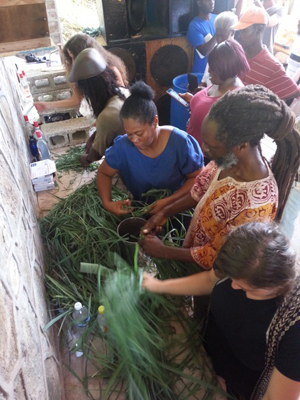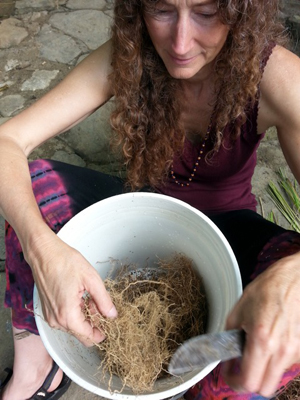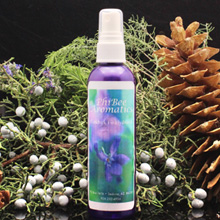Aromatherapy Newsletter: Summer 2016
Jamaica!
Dear Friends and Family,
 This Spring I (Clare) participated in a USAID funded, Partners of the Americas administered, Farmer-2-Farmer volunteer program in Jamaica. I was there for two weeks and taught four, full day essential oil distillation workshops. I was hosted by Kwao and Agape Adams (and their 6 lively and sweet boys!) at Yerba Buena Farm, which is also where we held the workshops. They have a small distiller that they bought to make essential oils for their soap business. It was in need of some modifications to increase the yield of essential oil, so we took it to Kingston. After 5 tries at various places, we found Faith Fabricators and Welders. Not only were they able to do what we needed, but we also found the right people to potentially build a larger distiller in the future.
This Spring I (Clare) participated in a USAID funded, Partners of the Americas administered, Farmer-2-Farmer volunteer program in Jamaica. I was there for two weeks and taught four, full day essential oil distillation workshops. I was hosted by Kwao and Agape Adams (and their 6 lively and sweet boys!) at Yerba Buena Farm, which is also where we held the workshops. They have a small distiller that they bought to make essential oils for their soap business. It was in need of some modifications to increase the yield of essential oil, so we took it to Kingston. After 5 tries at various places, we found Faith Fabricators and Welders. Not only were they able to do what we needed, but we also found the right people to potentially build a larger distiller in the future.
Working with the Jamaican people was a wonderful experience! There were 120 workshop participants altogether who were Organic Farmers, Bee keepers, people with cottage industries and in the healing arts, Naturopathic doctors, College professors and their students, representatives from RADA (the Rural Agricultural Development Agency), and last but certainly not least, nature enthusiasts. They came from 12 of the 14 parishes, and some people traveled up to 4 hours to get there. The enthusiasm for the subject matter was tremendous. People had such good questions that it was clear that they have been thinking about the possibilities of distilling their own essential oils for quite some time!
 Jamaica does have some large-scale essential oil distillation history that mainly has centered around Pimento (Allspice) Berry. This is an abundant native plant, which produces copious amounts of hot, spicy oil. There are also many other introduced tropical plants on the island, which are well known to Aromatherapy and currently not being distilled. Before leaving for this trip, I was given a list of almost 30 plants that we could potentially distill in our workshops. I decided to make a notebook to compile information on cultivating and distilling these plants. It turned into two, 2½ inch thick notebooks, and this was not even including the less known, native medicinal plants!
Jamaica does have some large-scale essential oil distillation history that mainly has centered around Pimento (Allspice) Berry. This is an abundant native plant, which produces copious amounts of hot, spicy oil. There are also many other introduced tropical plants on the island, which are well known to Aromatherapy and currently not being distilled. Before leaving for this trip, I was given a list of almost 30 plants that we could potentially distill in our workshops. I decided to make a notebook to compile information on cultivating and distilling these plants. It turned into two, 2½ inch thick notebooks, and this was not even including the less known, native medicinal plants!
We now have Jamaican Essential Oils in stock. Take a look!
Essential oils are very expensive in Jamaica because they are all imported. This makes them prohibitive for many people wishing to enhance their products, or add to their therapeutic treatments. The Jamaicans are wishing for local, Artisan distilled essential oils, and expressed great openness to the idea of co-operatives to make this happen. True prosperity is not just individual financial success, it includes health, sharing, and strengthening of community. A small scale essential oil industry could help provide this in Jamaica. It is a beautiful opportunity, and I look forward to seeing what will happen.
 Years ago, the Jamaican government encouraged farmers to plant Lemongrass (known in Jamaica as Fevergrass). Many people did so, but soon there was plenty of Lemongrass on the world market, and they were left with tons of plant material which they had no commercial use for. While I was there we did 5 distillations of Lemongrass. With each distillation we learned more about how to achieve a greater yield of essential oil. The oil is fantastic! It has the characteristic lemony aroma, but it is also very earthy, thick and long lasting. The hydrosol is also very interesting. It was always very opaque, in spite of how cold we kept the condensor.
Years ago, the Jamaican government encouraged farmers to plant Lemongrass (known in Jamaica as Fevergrass). Many people did so, but soon there was plenty of Lemongrass on the world market, and they were left with tons of plant material which they had no commercial use for. While I was there we did 5 distillations of Lemongrass. With each distillation we learned more about how to achieve a greater yield of essential oil. The oil is fantastic! It has the characteristic lemony aroma, but it is also very earthy, thick and long lasting. The hydrosol is also very interesting. It was always very opaque, in spite of how cold we kept the condensor.
Pimento trees are dioecious (meaning there are separate male and female plants). The male trees are more rare, but also have a greater yield of essential oil in their leaves. Often times the leaves are discarded during commercial harvesting of the berries. Yerba Buena Farm has both male and female trees on their land. There was a beautiful female tree towering over my cabin. Knowing that it has a high yield of essential oil, we felt confidant that a distillation in their small distiller would be fruitful. It was indeed, and what an amazing oil! It has a lighter than water fraction, and heavier than water fraction. This requires a special separator. Most of the oil that we obtained was heavier than water, which was a challenge to decant with the separator that we were working with. The oil is thick and very hot, with a scent that smells like a combination of Cinnamon, Clove and Nutmeg (hence the name Allspice). This is fantastic immuno supportive oil, excellent for eliminating fungus, bacteria, virus and parasites.
We now have Jamaican Essential Oils in stock. Take a look!
 Then there was the native, wild Vetiver (known as Khus Khus in Jamaica)! It was a dream of mine to work with this plant. I now have complete respect for distillers of Vetiver. It is a very long, labor intensive process. First the roots had to be dug (luckily some strong men did this work) and soaked in water so that we could massage the clay out of them. Then they had to be removed from the root ball, which was easier said than done. We then left them to dry. Ideally the roots are aged, but we did not have the luxury of this time. At least some of them got over one week of time. Commercial distillations of Vetiver can last anywhere from 36- 72 hours. Since we were working with a small distiller, that length of time was not necessary, but the distillation still lasted over a two day period. What an oil! It is thick like honey, and has a deep, earthy, clay like aroma. We cohobated the hydrosol over and over (meaning we added the hydrosol back into the distiller), and achieved a richness of aroma that I have not smelled in another Vetiver hydrosol. This is another oil that has lighter than water and heavier than water fractions, and is ideally received into a special separator. I understand now why many distillers of Vetiver work only with that one plant.
Then there was the native, wild Vetiver (known as Khus Khus in Jamaica)! It was a dream of mine to work with this plant. I now have complete respect for distillers of Vetiver. It is a very long, labor intensive process. First the roots had to be dug (luckily some strong men did this work) and soaked in water so that we could massage the clay out of them. Then they had to be removed from the root ball, which was easier said than done. We then left them to dry. Ideally the roots are aged, but we did not have the luxury of this time. At least some of them got over one week of time. Commercial distillations of Vetiver can last anywhere from 36- 72 hours. Since we were working with a small distiller, that length of time was not necessary, but the distillation still lasted over a two day period. What an oil! It is thick like honey, and has a deep, earthy, clay like aroma. We cohobated the hydrosol over and over (meaning we added the hydrosol back into the distiller), and achieved a richness of aroma that I have not smelled in another Vetiver hydrosol. This is another oil that has lighter than water and heavier than water fractions, and is ideally received into a special separator. I understand now why many distillers of Vetiver work only with that one plant.
We also did a maceration of Vetiver roots in a locally produced Coconut oil, and this too is heavenly. The Coconut oil has a slightly roasted aroma, which adds another beautiful dimension to the scent. This is an easily made and relatively inexpensive product that the Jamaicans could supply to the local Spas and Resorts, or make just for their own enjoyment.
 A neighbor brought us some Rosemary, which I initially was not to excited about because I frequently distill it here. It was new to the Adams though, and we certainly didn’t want to waste it, so we distilled it up. My enthusiasm returned as the distillation yielded a beautiful sweet oil. It has none of the harshness that Rosemary essential oil can have. I am very curious about the chemotype of this oil, because Jamaica has such a different climate from any of the regions where Rosemary natively grows. In Arizona we have the cineole type, because our environment is most similar to that of North Africa and Southern Spain. The Jamaican leaves were notably softer, and I suspect that the tropics could produce a different chemotype altogether.
A neighbor brought us some Rosemary, which I initially was not to excited about because I frequently distill it here. It was new to the Adams though, and we certainly didn’t want to waste it, so we distilled it up. My enthusiasm returned as the distillation yielded a beautiful sweet oil. It has none of the harshness that Rosemary essential oil can have. I am very curious about the chemotype of this oil, because Jamaica has such a different climate from any of the regions where Rosemary natively grows. In Arizona we have the cineole type, because our environment is most similar to that of North Africa and Southern Spain. The Jamaican leaves were notably softer, and I suspect that the tropics could produce a different chemotype altogether.
We now have Jamaican Essential Oils in stock. Take a look!
On my last day in Jamaica, we were able to get in a distillation of Sea Rosemary (Croton linearis), a native to Jamaica, which has a long history of herbal usage. Having never distilled this plant before, we had no idea what to expect. We were initially disappointed with the results of the distillation because the yield was so low. The Adams gave the tiny bottle of oil to me because this is not a plant that I could ever distill here. I open it about once a week and smell it to see how it is changing. As the oil has matured, a fantastic aroma has emerged. It has a lemon lime peel scent that is very uplifting. They will be working with it more to see how they might coax more oil from the leaves. It is worth the effort! I look forward to learning more about this plants healing properties and essential oil chemistry.
 My only regret from this trip was that there was not more time to go on native plant wildcrafting expeditions. My hope is to go on two more trips to Jamaica. The first would be purely a research trip, and the second would be to hold another series of public workshops. In the public workshops we would go into greater detail about the properties and uses of the native, naturalized and cultivated plants of the island.
My only regret from this trip was that there was not more time to go on native plant wildcrafting expeditions. My hope is to go on two more trips to Jamaica. The first would be purely a research trip, and the second would be to hold another series of public workshops. In the public workshops we would go into greater detail about the properties and uses of the native, naturalized and cultivated plants of the island.
There is an aromatic richness and strength that is present in all of the Jamaican oils, and it is a reflection of the people and place. I can’t wait to see what comes out of our time together. There is so much potential! Hopefully in the not to distant future, we will be able to offer a line of Jamaican, Artisan Distilled essential oils from Yerba Buena Farm.
It was my supreme joy and honor to spend these two weeks at Yerba Buena Farm, and to meet so many lovely and inspiring Jamaican people. I would like to express my sincere gratitude to USAID and Partners of the Americas for this opportunity that was a gift for all of us.
Clare and Max
We now have Jamaican Essential Oils in stock. Take a look!
Jamaica Photo Gallery
 A distillation training day |
 After a long day |
 Agape cutting Vetiver roots |
 Agape washing Vetiver |
 A wonderful group of people |
 Beach at Yerba Buena Farms |
 The beginning of YBF's library |
 Clare cutting Vetiver roots |
 Distilling Vetiver at night |
 Firing up the distiller |
 Kudjoe helping with Lemongrass |
 Kudjoe helping with Vetiver |
 Kwao and Clare clipping Pimento |
 Lemongrass Essential Oil and Hydrosol |
 Lloyd and Lemongrass |
 Melchizedek clipping Rosemary |
 My cabin under a Pimento tree |
 Pimento Leaves |
 Processing Lemongrass |
 Processing Lemongrass |
 View from my cabin |
 Yerba Buena Farm kitchen |
 Lemongrass at Yerba Buena Farm |
 RADA group |


